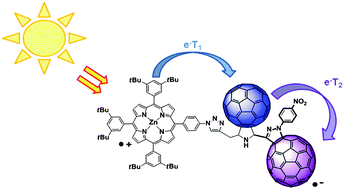Powering reductive charge shift reactions—linking fullerenes of different electron acceptor strength to secure an energy gradient†
Abstract
We report here on one of the rare cases that realizes a reductive charge shift from a primary

Maintenance work is planned for Wednesday 1st May 2024 from 9:00am to 11:00am (BST).
During this time, the performance of our website may be affected - searches may run slowly and some pages may be temporarily unavailable. If this happens, please try refreshing your web browser or try waiting two to three minutes before trying again.
We apologise for any inconvenience this might cause and thank you for your patience.
* Corresponding authors
a
Departamento de Química Orgánica, Facultad de Ciencias Químicas, Universidad Complutense de Madrid, Ciudad Universitaria s/n, Madrid, Spain
E-mail:
nazmar@quim.ucm.es
Fax: (+34) 91-394-4103
Tel: (+34) 91-394-4227
b IMDEA-Nanociencia, Facultad de Ciencias, Módulo C-IX, 3a planta, Ciudad Universitaria de Cantoblanco, Madrid, Spain
c
Department of Chemistry and Pharmacy & Interdisciplinary Center of Molecular Materials (ICMM) Friedrich-Alexander-University Erlangen-Nuremberg Egerlandstr. 3, Erlangen, Germany
E-mail:
dirk.guldi@chemie.uni-erlangen.de
Fax: (+49) 9131-85-28307
We report here on one of the rare cases that realizes a reductive charge shift from a primary

 Please wait while we load your content...
Something went wrong. Try again?
Please wait while we load your content...
Something went wrong. Try again?
C. Villegas, J. L. Delgado, P. Bouit, B. Grimm, W. Seitz, N. Martín and D. M. Guldi, Chem. Sci., 2011, 2, 1677 DOI: 10.1039/C1SC00331C
To request permission to reproduce material from this article, please go to the Copyright Clearance Center request page.
If you are an author contributing to an RSC publication, you do not need to request permission provided correct acknowledgement is given.
If you are the author of this article, you do not need to request permission to reproduce figures and diagrams provided correct acknowledgement is given. If you want to reproduce the whole article in a third-party publication (excluding your thesis/dissertation for which permission is not required) please go to the Copyright Clearance Center request page.
Read more about how to correctly acknowledge RSC content.
 Fetching data from CrossRef.
Fetching data from CrossRef.
This may take some time to load.
Loading related content
